
Building vs Buying Is Dead: How Hybrid SaaS + Microservices Win the Future
October 07, 2025 / Bryan Reynolds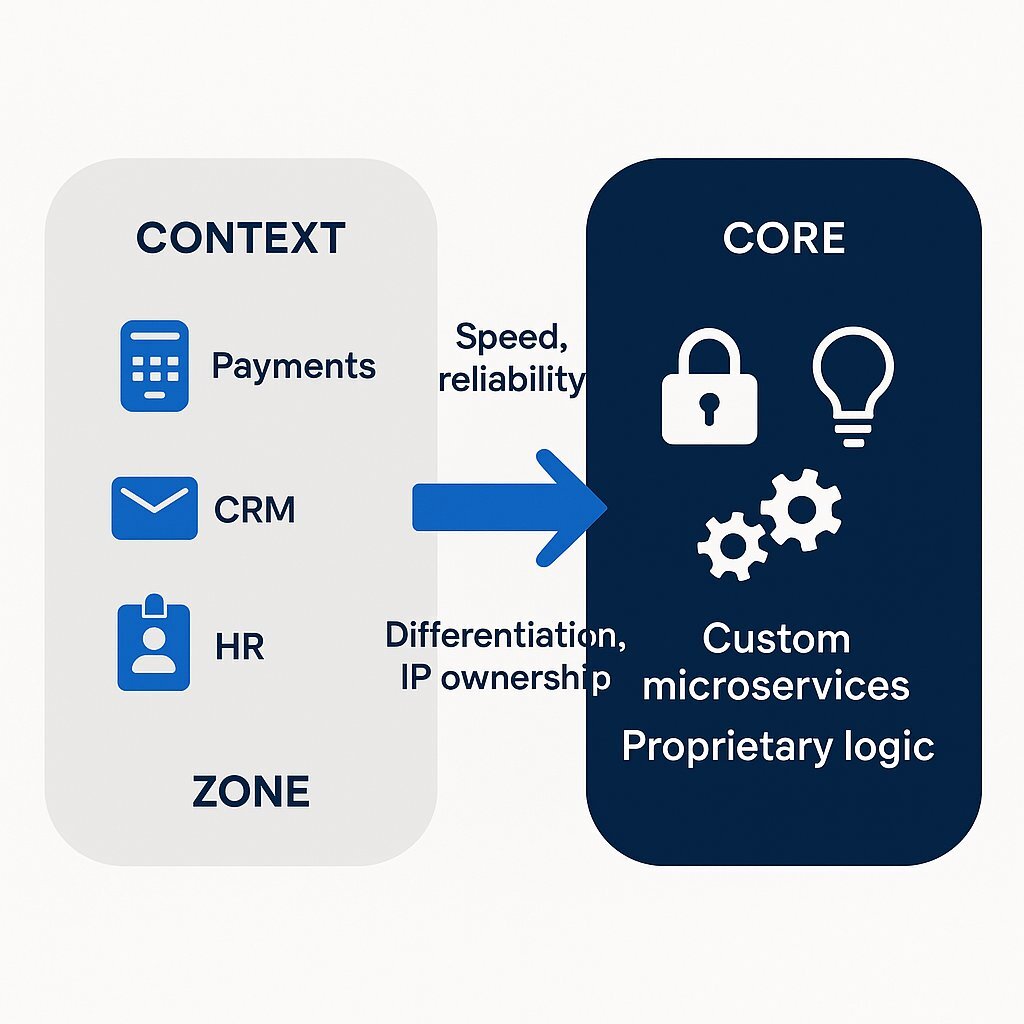
The Build vs. Buy Fallacy: Why Your Future is a Hybrid of SaaS and Custom Microservices
As a technology leader, you're perpetually caught in a tug-of-war. Do you build a custom monolith that perfectly fits your needs today but becomes a technical anchor tomorrow? Or do you commit to an all-in-one SaaS suite that promises speed but forces your unique processes into a generic box? This debate, framed as a simple binary choice between "build" and "buy," has dominated architectural discussions for years. But it's a false dichotomy.
The most resilient, innovative, and competitive enterprises are moving beyond this outdated binary. They are architecting a sophisticated hybrid model that represents a third, superior path. This strategy involves a deliberate and surgical approach: buying best-in-class, API-driven Software-as-a-Service (SaaS) products for commodity functions and building a constellation of custom microservices to handle the unique business logic that creates a deep, defensible competitive advantage. This isn't a compromise; it's the blueprint for a composable, agile, and future-proof enterprise.
The Twin Traps of "All-In" Architecture
Before embracing the hybrid future, it's critical to understand why the two extreme approaches—the all-custom monolith and the all-in-one SaaS suite—are fundamentally flawed for the modern digital economy. Both create traps that can stifle growth, inhibit innovation, and introduce unacceptable levels of risk.
The Monolithic Mire: When Your Foundation Becomes Your Constraint
A monolithic architecture, where an entire application is built as a single, interconnected system, is often the default choice for new projects. It's straightforward to develop and deploy initially, making it attractive for startups needing to get a product to market quickly. However, this initial simplicity is deceptive. As a successful application grows in size and complexity, the monolithic foundation begins to crack under its own weight, transforming from an asset into a significant liability.
- Inflexibility and Slow Deployment: The hallmark of a monolith is its tightly coupled nature. All components and functions are interdependent, meaning a small change in one part of the application can have cascading, unpredictable effects on others. This introduces massive risk into the development cycle. To update a single feature, the entire application must be recompiled, retested, and redeployed. This process is slow, cumbersome, and directly at odds with the agile, iterative cycles that modern businesses demand. Worse, the entire application becomes a single point of failure; a minor bug in an isolated module can bring down the entire system, leading to severe service outages.
- Scalability Challenges: Monolithic applications are notoriously inefficient to scale. Because all functionalities are contained within a single codebase, the entire application must be scaled as a single unit, even if only one specific function is experiencing increased demand. For instance, if a traffic surge hits your user notification service, you are forced to deploy another complete instance of the entire application—including the billing, reporting, and admin modules that are under normal load. This "all or nothing" scaling leads to significant resource wastage and drives up infrastructure costs unnecessarily.
- Technology Lock-In: A monolith commits you to the technology stack chosen on day one. As the codebase grows, migrating to a new, more efficient programming language or a modern framework becomes a monumental undertaking that is often prohibitively expensive and time-consuming. This technological inertia prevents the organization from adopting modern tools and trends, creating a growing gap between your capabilities and those of more agile competitors. Eventually, the development effort to simply manage the complexity of the legacy code eclipses the effort spent building new, value-generating features.
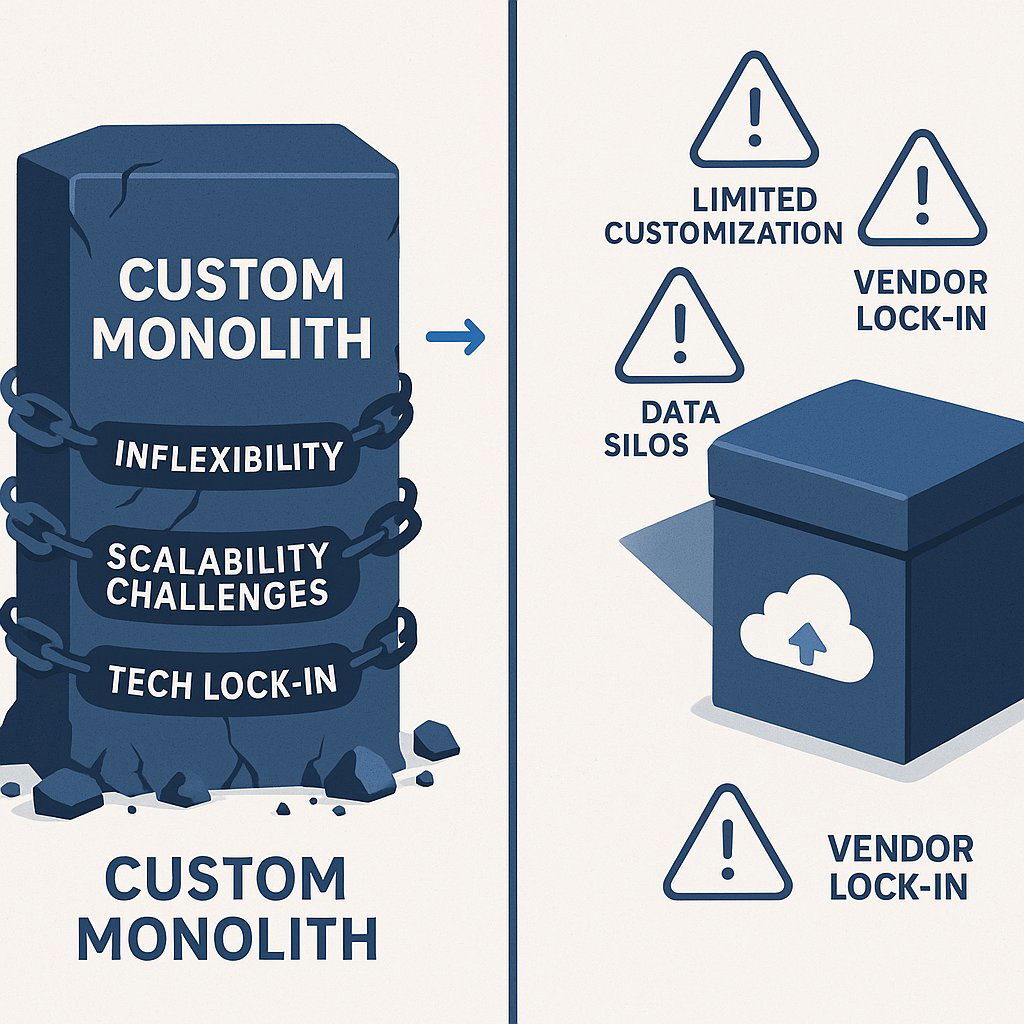
The SaaS Suite Ceiling: The Hidden Costs of Convenience
On the other end of the spectrum are the all-in-one SaaS suites. These platforms promise a turnkey solution, offering a broad range of functionalities with rapid implementation and predictable subscription costs. They excel at handling standardized business processes, but this convenience comes at a steep price: a hard ceiling on innovation and the creation of dangerous long-term dependencies.
- Limited Customization: SaaS vendors build their platforms to serve the broadest possible market, which means they optimize for the 80% use case. This one-size-fits-all approach forces you to adapt your business processes to the software's limitations, rather than the other way around. Your unique, differentiating workflows—the very things that give you an edge—are often compromised or abandoned to fit into the vendor's generic model. This effectively commoditizes your operations, making you look and act just like every other company using that same software.
- The Peril of Vendor Lock-In: This is the most significant strategic risk associated with an all-in SaaS strategy. When you build your core operations around a single vendor, you become deeply entangled in their proprietary technologies, data formats, and APIs. Migrating to a different provider becomes an incredibly complex, costly, and disruptive process, effectively "locking you in". This dependency gives the vendor immense leverage over your business. They can raise prices with little recourse, discontinue features you rely on, or suffer from performance issues that you are powerless to fix. A stark example was Google Cloud's abrupt shutdown of its IoT Core service in 2022, which forced customers into a frantic and costly migration to alternatives.
- Data Fragmentation and Silos: The "all-in-one" promise rarely holds true. Most organizations end up using a portfolio of best-of-breed SaaS tools for different functions (e.g., one for CRM, another for marketing, a third for support). This leads to critical business data being scattered across multiple, disconnected systems. The result is a fragmented view of the customer and a disjointed user experience. For example, a customer might report an issue to a sales rep via a chat widget, but the support team, using a different tool, has no visibility into that conversation. This requires building and maintaining complex, brittle "data plumbing" just to create a single source of truth.
The fundamental flaw shared by both architectural extremes is their rigidity in the face of change. Monoliths are built on the assumption that today's perfect custom fit will remain perfect tomorrow, while SaaS suites operate on the premise that a generic fit is "good enough" indefinitely. Both assumptions are invalid in a market that demands constant, differentiated evolution.
| Criterion | Custom Monolith | All-in-One SaaS Suite |
|---|---|---|
| Speed to Initial Market | Slow to Medium | Fast |
| Speed of Iteration (Post-Launch) | Very Slow; High-Risk Deployments | Fast (for vendor-defined features) |
| Potential for Differentiation | High (but brittle) | Low to None |
| Scalability Model | Inefficient (Scale Everything) | Efficient (Managed by Vendor) |
| Technology Flexibility | Very Low (Locked-in Stack) | None (Vendor Dictated) |
| Vendor Lock-In Risk | Low | Extremely High |
| Long-Term TCO | High (Maintenance & Scaling Costs) | High (Subscription Fees & Switching Costs) |
The Composable Vision: Architecting for an Unpredictable Future
The solution to the traps of monolithic and all-in-one architectures is not to choose the lesser of two evils, but to adopt a new paradigm altogether: the composable enterprise. This is an architectural vision where systems are not built as rigid, singular entities but are instead assembled from independent, interchangeable, and best-in-class components. This modular approach, heavily reliant on APIs for communication, provides the flexibility, agility, and resilience necessary to thrive in a dynamic business environment.
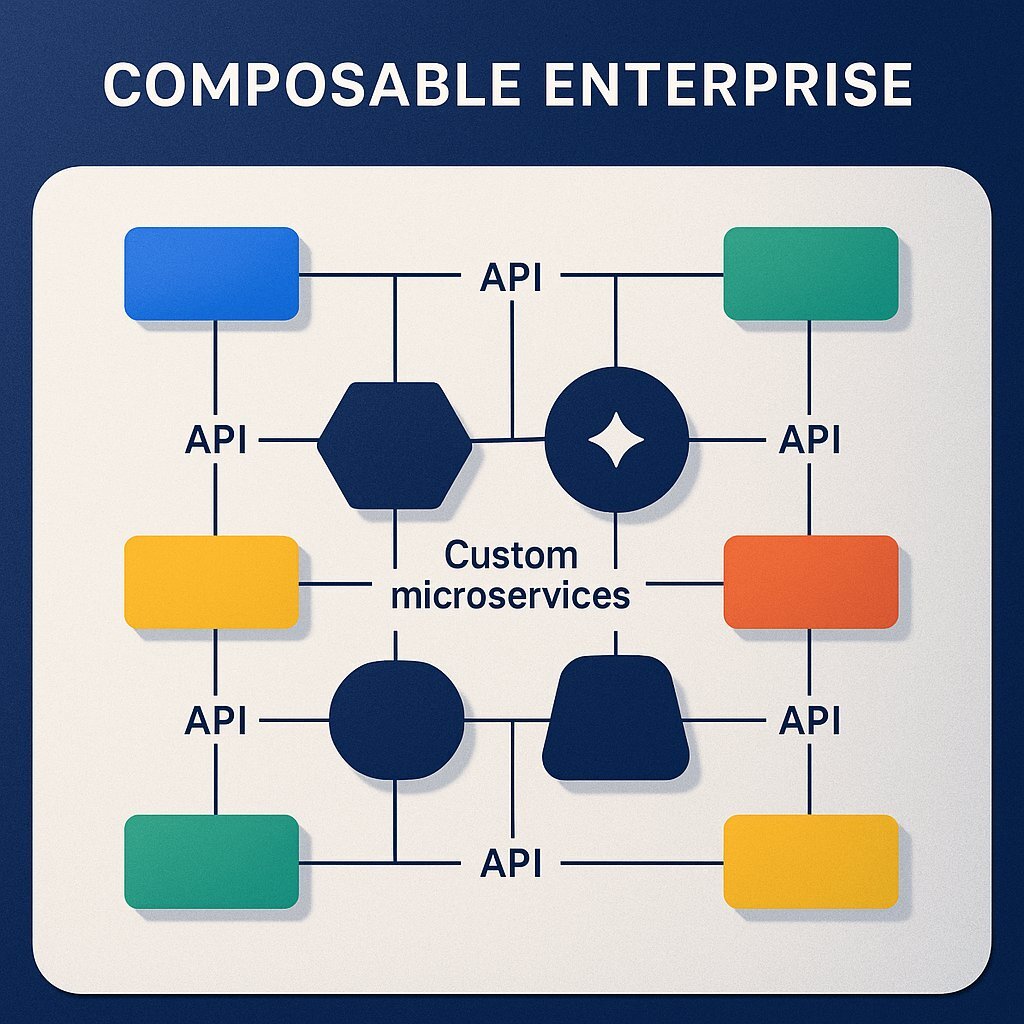
The Core Principle: Buy Your Context, Build Your Core
The practical application of the composable vision is guided by a simple yet powerful strategic framework: Buy your Context, Build your Core.
- "Context" refers to the commodity functions of your business. These are the operations that are absolutely necessary to run your company but do not, in themselves, provide a competitive advantage. Examples include basic payment processing, standard CRM data storage, payroll systems, and HR platforms. For these contextual functions, the strategy is to buy best-in-class, API-driven SaaS products.
- "Core" refers to your company's unique intellectual property—the "secret sauce." This is the proprietary logic, the complex algorithms, the specialized workflows, or the unique user experiences that differentiate you from everyone else in the market. This is what you must build , own, and protect at all costs.
This framework allows you to focus your most valuable resources on what truly matters, creating a system that is both efficient and highly differentiated.
The SaaS Foundation: Standing on the Shoulders of Giants
Leveraging market-leading SaaS platforms for your "context" is not a compromise; it's a massive strategic accelerator. By integrating with a provider like Stripe for payments or Salesforce for CRM, you are effectively outsourcing the immense cost and complexity of building and maintaining non-differentiating infrastructure.
You gain immediate access to world-class reliability, global scale, and robust security—features that would require years of effort and millions of dollars to replicate in-house. Think of the specialized knowledge required to maintain PCI compliance, manage global payment regulations, or ensure 99.999% uptime for a core database. Offloading this burden allows your team to focus on innovation rather than reinvention. The critical factor in this strategy is selecting SaaS vendors who have a true API-first philosophy. Their platform should not be a walled garden but a utility that can be consumed programmatically through well-documented, reliable, and powerful APIs.
The Microservice Constellation: Forging Your Competitive Moat
While SaaS provides the foundation, your custom-built microservices are where your competitive advantage is forged. By developing a constellation of small, independent, and loosely coupled services that orbit your SaaS foundation, you create a system that is a perfect expression of your unique business strategy. This is where you build your "core."
This approach leverages the inherent advantages of a microservices architecture, which is rapidly becoming the standard for modern enterprise applications, with nearly 85% of enterprises having already embraced it.
- Modularity & Independent Deployment: Each microservice is a self-contained unit of functionality. This allows small, focused teams to develop, test, and deploy new features for a specific service without coordinating with or risking the stability of the rest of the system. This dramatically accelerates your time-to-market for new innovations.
- Granular Scalability: If a specific function, like your custom pricing engine, experiences a heavy load, you can scale that one microservice independently. This targeted scalability optimizes resource allocation and is far more cost-effective than scaling a monolith.
- Technological Freedom: Microservices are technology-agnostic. Your team can choose the best programming language and database for each specific job. A real-time data processing service might be built in Go, while a machine learning model for fraud detection could be built in Python. This flexibility prevents the technological stagnation that plagues monolithic systems.
- Fault Isolation: The compartmentalized nature of microservices enhances system resilience. If one service fails, it doesn't bring down the entire application. The rest of the system can continue to function, isolating the blast radius of the failure and allowing for graceful degradation of service.
At Baytech Consulting, we call this the "Tailored Tech Advantage." It’s about strategically moving beyond generic, off-the-shelf solutions to craft a technology ecosystem that is a perfect and powerful reflection of your unique business model, powered by cutting-edge, custom-built components.
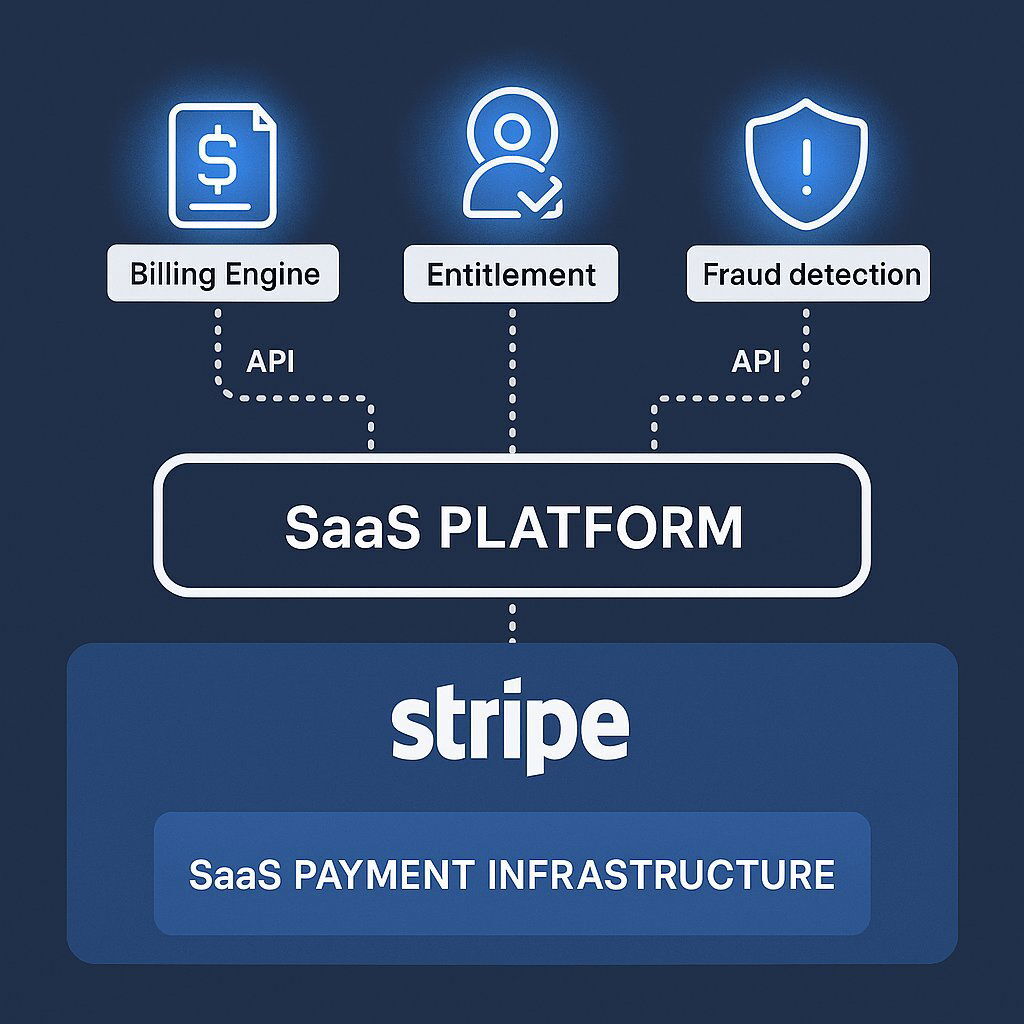
The Hybrid Model in Action: A Practical Playbook with Stripe
To make this architectural vision concrete, let's walk through a practical example. Imagine a B2B SaaS company operating in the highly specialized field of logistics technology. Their platform helps clients optimize shipping routes and manage complex supply chains.
The "Buy" Layer: Stripe as the Financial Operating System
This logistics tech company makes a strategic decision to not build any part of its payment infrastructure. Instead, it treats payments as "context" and leverages Stripe as its financial operating system.
- What they "Buy":
- Stripe Payments API: They use Stripe's core API to securely accept a wide range of payment methods from customers across the globe, supporting over 135 currencies without having to build and maintain individual banking relationships.
- Stripe Elements: For their checkout and payment forms, they use Stripe's pre-built, customizable UI components. This ensures a seamless user experience while completely offloading the burden of PCI compliance for handling sensitive credit card data.
- Stripe Billing: They use the basic functionality of Stripe Billing to create the final subscription records and send invoices, leveraging Stripe's reliable infrastructure for these commodity tasks.
By making this "buy" decision, the company avoids wasting precious engineering cycles on the undifferentiated heavy lifting of payment processing. They instantly gain access to a global, secure, and scalable financial infrastructure.
The "Build" Layer: Three Differentiating Custom Microservices
Here is where the company builds its "core" business logic. They develop a constellation of custom microservices that interact with their SaaS foundation (Stripe) to deliver a product that is impossible to replicate with an off-the-shelf solution.
- 1. The Complex Usage-Based Billing Microservice:
- The Problem: Their pricing model is their secret sauce. It's not a simple flat monthly fee. They charge clients based on a complex, multi-factor formula that includes the number of shipments tracked, the volume of data processed, and the number of API calls made to their optimization engine, complete with tiered discounts and overage fees. No standard SaaS billing platform can handle this proprietary logic.
- The Solution: They build a custom microservice dedicated to pricing and rating. This service continuously ingests usage data from their core application. At the end of each billing cycle, it applies the company's unique and proprietary pricing algorithms to calculate the final amount due. It then makes a simple API call to Stripe, instructing it to create an invoice for that specific calculated amount. The core intellectual property of their business model lives securely within this custom microservice, not in a third-party system.
- 2. The Dynamic Subscription & Entitlement Microservice:
- The Problem: Their customers are large enterprises with complex needs. They need to bundle different product modules (e.g., route optimization, warehouse management, international compliance), add temporary capacity for seasonal peaks, and negotiate custom enterprise-level contracts. The logic determining what features a user is entitled to access is highly dynamic and unique to their business.
- The Solution: They build a custom entitlement microservice that acts as the single source of truth for all customer subscriptions and permissions. This service integrates with their user authentication system to grant or deny access to specific features in real-time. When a sales rep closes a complex enterprise deal, the contract details are fed into this microservice, which then orchestrates the necessary actions: it tells the billing microservice how to rate usage for this customer and updates the subscription record in Stripe. This architecture decouples their flexible, enterprise-grade product offerings from the simpler mechanics of a payment system. This mirrors how companies like Lyft built custom logic like Express Pay on top of Stripe's core payout infrastructure to meet the unique needs of their drivers.
- 3. The Industry-Specific Fraud Detection Microservice:
- The Problem: Stripe's built-in fraud detection tool, Radar, is excellent for identifying common e-commerce fraud patterns. However, the logistics industry has unique fraud vectors, such as fraudulent shipping manifests, manipulated delivery data, or account takeovers aimed at rerouting valuable cargo. Radar alone cannot detect this specialized, industry-specific fraud.
- The Solution: They build a custom fraud detection microservice that uses machine learning models trained on logistics-specific data. This service takes Stripe's initial fraud score as one of its inputs. It then combines that score with its own analysis of industry-specific signals (e.g., unusual route changes, discrepancies between manifest and weight data). The microservice provides a final, more accurate risk assessment and sends a definitive "approve" or "deny" decision back to the payment workflow via an API call. They augment a best-in-class SaaS tool with their own deep domain expertise, ensuring advanced protection in today's evolving risk landscape. Learn more about how supply chain threats and targeted attacks are changing the risk calculus for SaaS and custom software users alike.
This hybrid model fundamentally changes the strategic role of SaaS platforms. They are transformed from restrictive, self-contained applications into a powerful, open "utility grid." The value of a SaaS provider is no longer confined to its user interface and feature set; it is defined by the quality, reliability, and extensibility of its APIs. This shift in perspective means that when evaluating a new SaaS vendor, a CTO's primary concern should be the power of their API, as this is what unlocks the platform's potential to become a foundational component in a larger, more strategic, and custom-tailored system. This pattern is not unique to payments; it's seen across the ecosystem with platforms like Salesforce and HubSpot, where companies build custom microservices to extend the core platform for industry-specific needs.
The C-Suite Payoff: Translating Architecture into Business Value
This hybrid, composable architecture is not just a technically elegant solution; it delivers tangible business outcomes that resonate across the entire C-suite, from the CTO to the CFO and CEO.
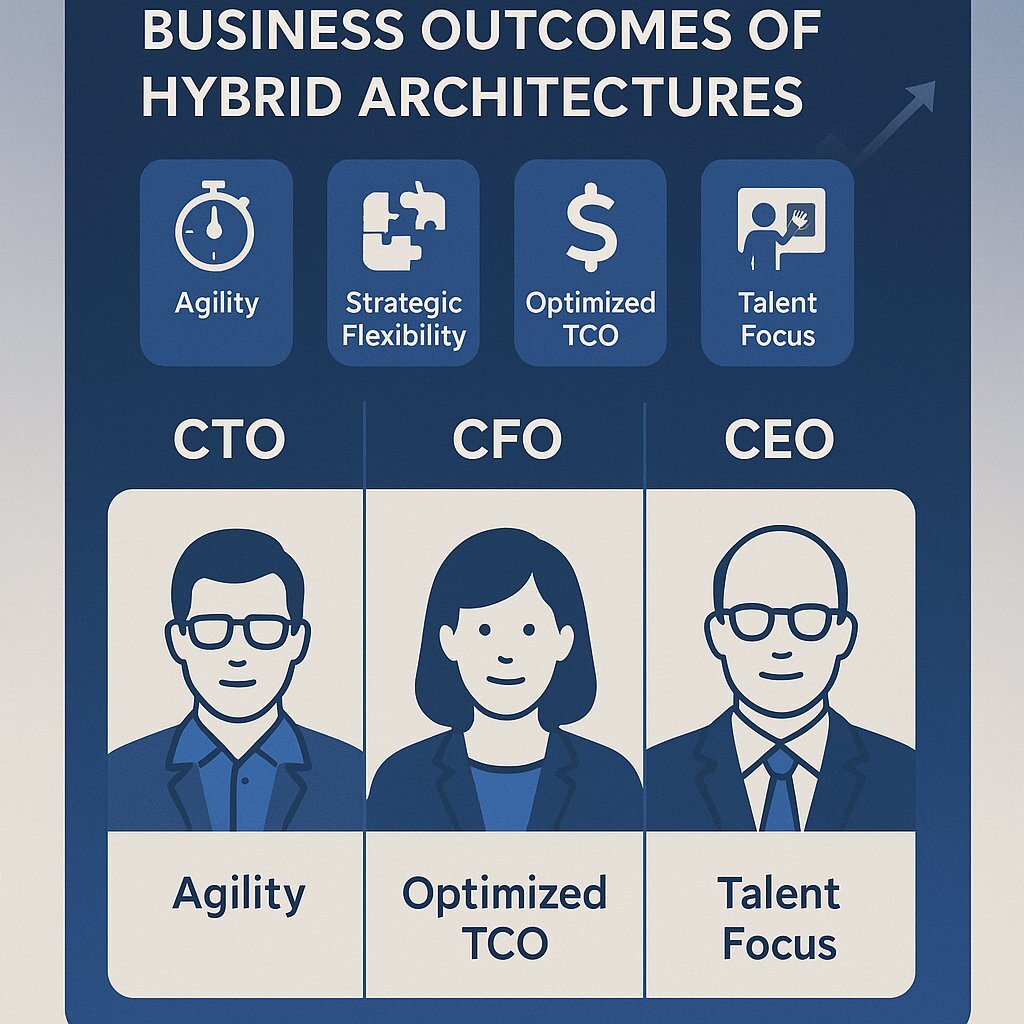
Radical Agility and Accelerated Time-to-Market
This architecture is engineered for speed. By breaking down the "core" logic into independent microservices, small, autonomous teams can work in parallel. A team can develop, test, and deploy an update to the entitlement service without affecting the work being done on the billing service. This enables a continuous delivery pipeline where new features and improvements can be rolled out to customers in days or even hours, not the months-long cycles associated with monoliths. This delivers a powerful post-launch advantage where speed meets resiliency, helping sustain your edge.
"Rapid Agile Deployment" philosophy at Baytech Consulting—structuring both technology and teams to create a continuous flow of value to the business.
Strategic Optionality: The End of Vendor Lock-In
This is a critical benefit for long-term strategic planning. In our logistics tech example, the company's core pricing and entitlement logic—their most valuable IP—resides in their own custom microservices. Stripe is simply the "plumbing" that executes the final payment. If, in the future, a new payment processor emerges that offers better rates or superior features, the company is not trapped. They can simply build a new, small "adapter" microservice to communicate with the new vendor's API and then swap out Stripe. The core business logic remains untouched. This architectural separation turns the relationship with a SaaS provider from a permanent marriage into a strategic partnership that can be re-evaluated, giving the company tremendous negotiating leverage and future flexibility.
Optimized TCO and Sharpened Resource Focus
The hybrid model provides a more optimized Total Cost of Ownership (TCO). It avoids the massive capital expenditure and ongoing maintenance burden of building commodity systems (like a payment gateway) from the ground up. At the same time, it mitigates the risk of escalating subscription fees and the astronomical hidden costs of migrating away from a vendor you are locked into. For organizations planning technology investments, understanding custom software budgeting strategies and TCO helps position the hybrid model for leadership buy-in.
The most significant financial benefit, however, is in the allocation of human capital. Your senior engineers are your most valuable and expensive resource. This model allows you to focus their talent and energy on building the "core" features that win customers, create differentiation, and drive revenue, rather than having them reinvent the "context" wheel that has already been perfected by a market-leading SaaS provider.
| Business Metric | Monolith | All-in-One SaaS | Hybrid (SaaS + Microservices) |
|---|---|---|---|
| Innovation Velocity | -- | - | ++ |
| Strategic Flexibility | -- | -- | ++ |
| Operational Resilience | - | + | ++ |
| Scalability Efficiency | - | ++ | ++ |
| Talent Focus (Core vs. Context) | Mixed | Context | Core |
| Risk of Obsolescence | High | Medium | Low |
Your Roadmap to a Hybrid, Composable Architecture
Transitioning to a hybrid, composable architecture is a strategic journey, not an overnight switch. It requires a deliberate, step-by-step approach. For many organizations, this path mirrors the critical discovery phase in successful custom software projects—risk is reduced, and outcomes are clarified by incremental, intentional change.
Step 1: Conduct a "Core vs. Context" Audit
The first and most critical step is to create a strategic map of your technological landscape. Assemble your business and technology leaders and meticulously review all of your current systems and processes. For each component, ask the fundamental question: "Is this a function that makes us unique and wins us customers (Core), or is it a necessary cost of doing business that is not a differentiator (Context)?" Be brutally honest in your assessment. This audit will produce a clear blueprint identifying which functions are candidates to be "bought" from best-in-class SaaS providers and, more importantly, where you must invest your resources to "build" and own your competitive advantage.
Step 2: Embrace an API-First Design Philosophy
A composable architecture is held together by APIs. To succeed, you must instill an API-first culture within your development organization. This means that for any new service being built—especially your "core" microservices—the development process must begin with the design of a clean, well-documented, and stable API contract. The API is not an afterthought; it
is the product. This disciplined approach ensures that your services are built from the ground up to be reusable, consumable, and integratable, which is the foundational requirement for a loosely coupled, modular system. Adopting this approach ensures your technology is ready for modern demands—see our practical guide to the Agile Manifesto's real business value for organizations driving this change.
Step 3: Identify a Pilot Project
Do not attempt a "big bang" transformation. The most effective way to build momentum and prove the value of the hybrid model is to start with a well-defined pilot project. Using the output from your "Core vs. Context" audit, select a single, high-impact business process. Choose a robust, API-driven SaaS platform to handle the "context" and scope the development of your first differentiating microservice to handle the "core" logic. A successful pilot will not only deliver immediate business value but will also build crucial institutional knowledge and create the organizational buy-in needed for a broader architectural evolution.
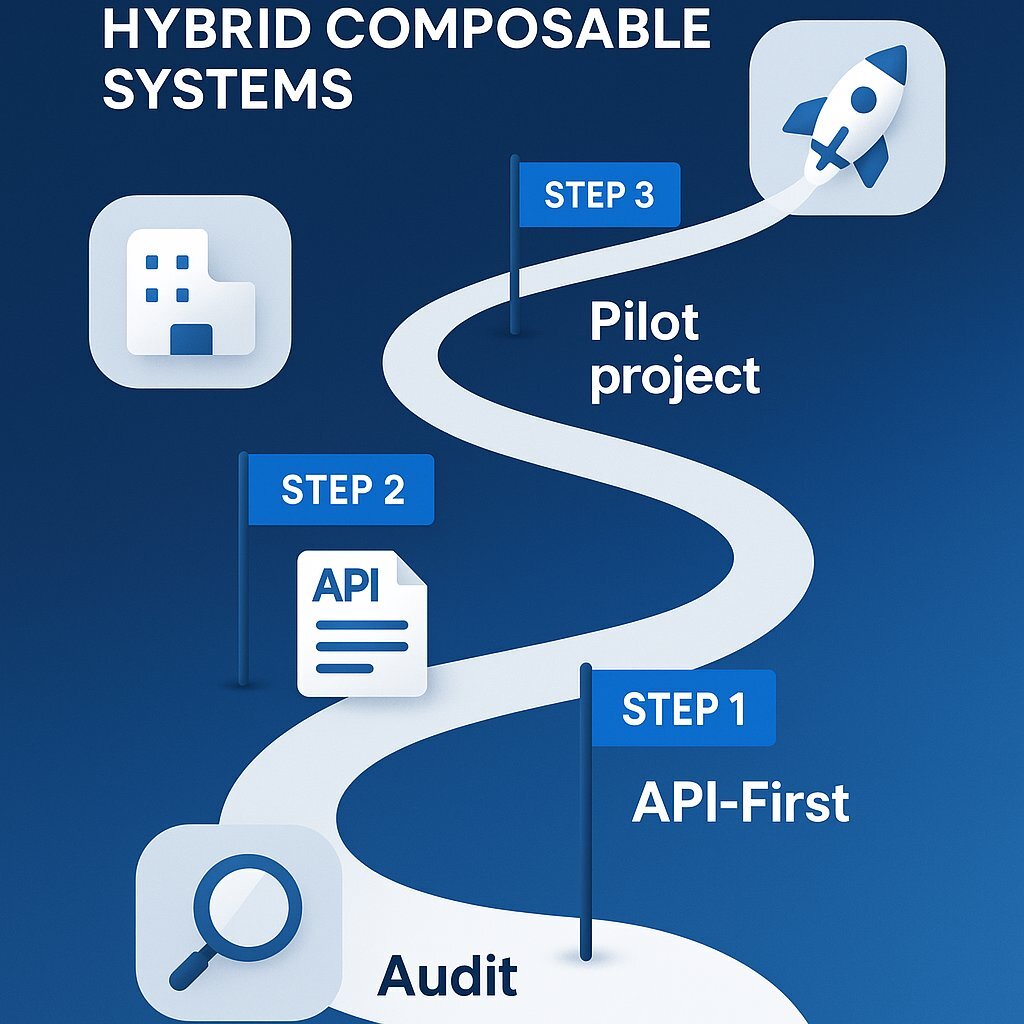
Conclusion: The Future is Assembled, Not Just Built or Bought
The debate is over. The monolithic architectures of the past are too slow and rigid for the pace of modern business. The all-in-one SaaS suites, while convenient, impose a ceiling on innovation and create unacceptable strategic risks. The most successful and enduring companies of the next decade will not be the ones who simply build everything from scratch or rent everything from a single vendor. They will be the master assemblers.
These future leaders will be the organizations that artfully and strategically combine the world's best commodity SaaS components with their own unique, custom-built microservices. They will weave these elements together to create an agile, resilient, and inimitable technology platform that is a true reflection of their business strategy. The future isn't about choosing between building and buying. It's about having the architectural wisdom to know what to build, what to buy, and how to create a whole that is far greater than the sum of its parts.
Architecting this future requires not just technical skill, but strategic foresight. If you're ready to move beyond the limitations of the past and build a truly composable enterprise, let's have a conversation. The team of expert engineers at Baytech Consulting specializes in designing and deploying the custom microservice constellations that turn great companies into market leaders. If you want to learn more about how custom software is currently driving competitive edge—and why enterprises are increasingly blending SaaS with tailored development—explore our latest insights.
Further Reading
- https://www.walkme.com/glossary/composable-enterprise/
- https://swagger.io/resources/articles/adopting-an-api-first-approach/
- https://www.goodreads.com/book/show/34372564-microservice-patterns
About Baytech
At Baytech Consulting, we specialize in guiding businesses through this process, helping you build scalable, efficient, and high-performing software that evolves with your needs. Our MVP first approach helps our clients minimize upfront costs and maximize ROI. Ready to take the next step in your software development journey? Contact us today to learn how we can help you achieve your goals with a phased development approach.
About the Author

Bryan Reynolds is an accomplished technology executive with more than 25 years of experience leading innovation in the software industry. As the CEO and founder of Baytech Consulting, he has built a reputation for delivering custom software solutions that help businesses streamline operations, enhance customer experiences, and drive growth.
Bryan’s expertise spans custom software development, cloud infrastructure, artificial intelligence, and strategic business consulting, making him a trusted advisor and thought leader across a wide range of industries.


